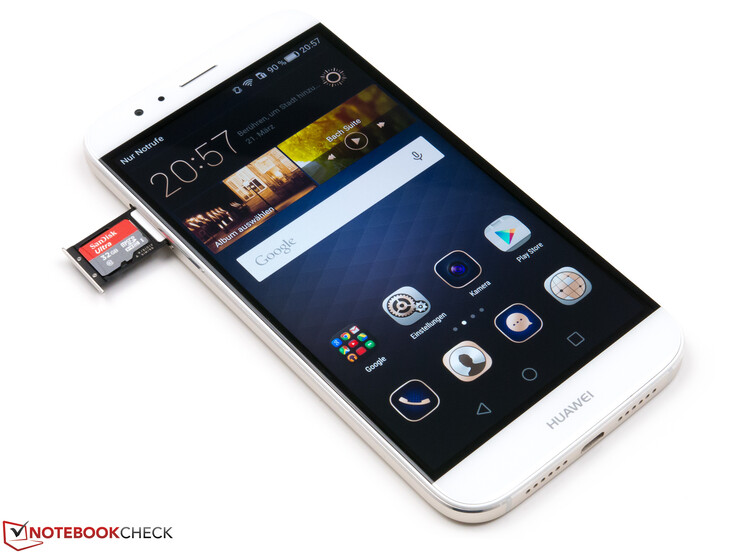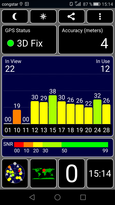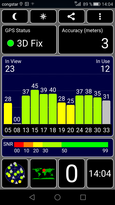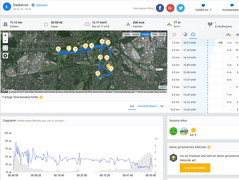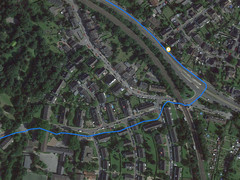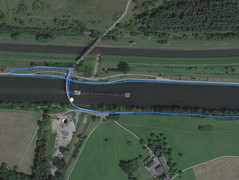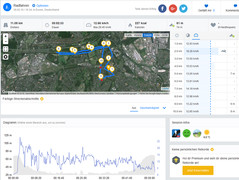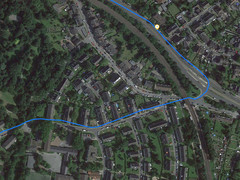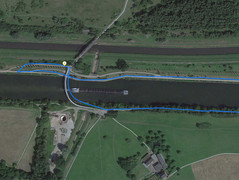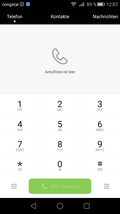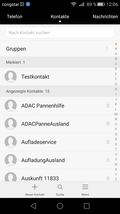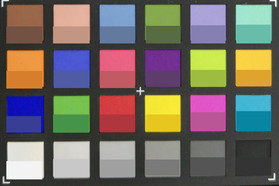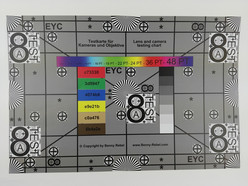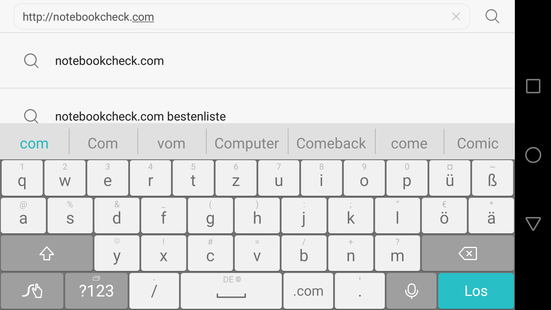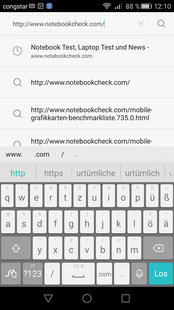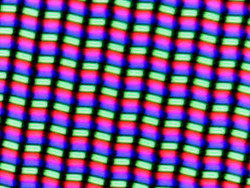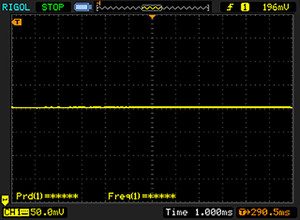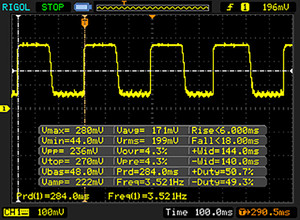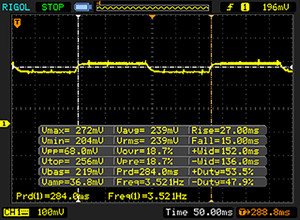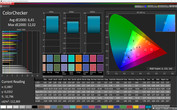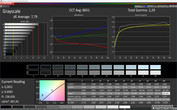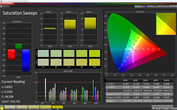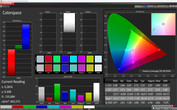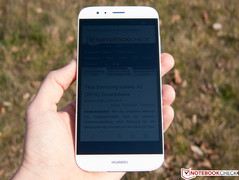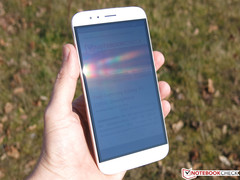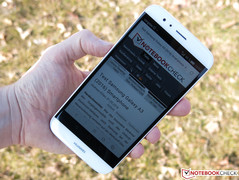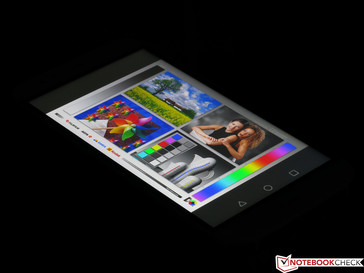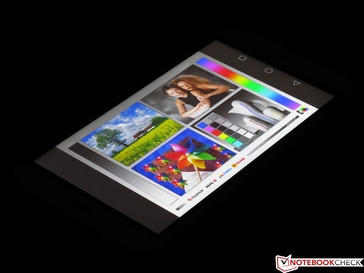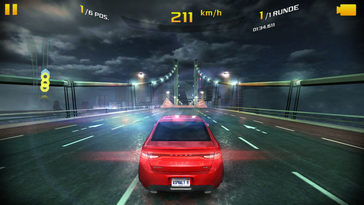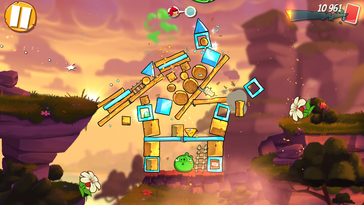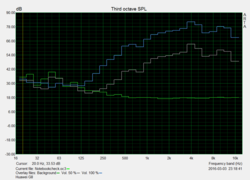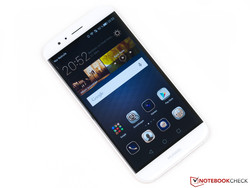Huawei G8 (GX8) Smartphone Review
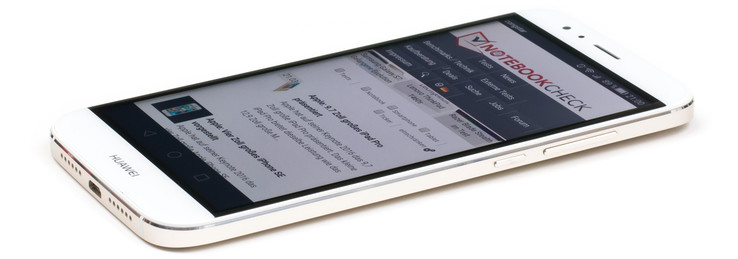
For the original German review, see here.
Last year, Huawei launched a particularly high-quality built smartphone with a 5.5-inch display on the market with its Mate S. Its price was also situated in the premium sector. The new G8 mid-range model has some identical features, such as the primary camera or the memory configuration as well as 32 GB of storage and 3 GB of RAM that are always on board. However, differences are found in the utilized panel technology and installed SoC among other things. Buyers who opt for the G8 - also GX8 on some markets - can choose between gold, gray and silver casing colors. A dual-SIM model is also available.
Our silver review sample ("Mystic Champagne") features a dual-SIM slot and currently costs around 330 Euros (~$376). The G8 has some strong opponents in this price range, such as the brand new Honor 5X and the Samsung Galaxy A5 (2016). Motorola's Moto X Play and OnePlus' 2 could also impress our testers with their good overall package. Outside the Android world, a look at Microsoft's Lumia 950 could be worthwhile, although it is slightly more expensive, starting at a street price of 450 Euros (~$513).
Case
Huawei's G8 features a metal bezel that encloses a large part of the back and the sides. The components' impeccable fitting and the 2.5D glass that covers the entire front give the handset an extremely high-quality feel. Plastic elements are only seen on the back's upper and lower areas with a pleasant, non-slip texture.
The G8 resists warping attempts; only strong pressure on the touchscreen causes minor wave formation on the panel.
The review sample's dimensions and weight are similar to other smartphones with a 5.5-inch screen. Only Samsung's Galaxy A5 and Microsoft's Lumia 950, equipped with 5.2-inch screens, are more compact. Our review sample did not meet the casing’s height of 7.5 millimeters (~0.3 in) that Huawei specifies. We measured an average of 8 millimeters (~3.1 in) plus another millimeter in the camera's area. However, subjectively, this does not ruin the slim impression.
Connectivity
For a mid-range handset, the connectivity of Huawei's G8 is very impressive. The smartphone has a decent 32 GB of storage, 3 GB of RAM and a micro-SD/nano-SIM slot combo. Applications can be moved to the memory card when one is inserted. The manufacturer has even remembered to install a notification LED. It is situated on the right of the earpiece. The conventional micro-USB port supports USB OTG, and wireless connections are possible via Wi-Fi Direct, Bluetooth 4.0 and NFC. In addition, DLNA and "MultiScreen" are present for streaming media. The latter is presumably Miracast. However, a video signal could not be transmitted during the test with an Amazon Fire Stick.
Software
Huawei covers the preloaded Android 5.1 operating system with its own EMUI 3.1 user interface - an update to Android 6.0 is in the works. Compared with Google's untouched operating system, the G8 lacks an app drawer and therefore, all installed apps appear on the home screen. Other modifications affect customizing looks via design templates and the integrated phone manger. Users who miss the option of setting rights for apps can download this feature via Huawei's app "PM Plus" from the Play Store. Some third-party apps - Facebook, Twitter, WPS Office, To-doist and various Gameloft games - are preloaded ex-factory, but they can be completely uninstalled when not wanted.
We discovered a small bug when we changed to the overview of frequently opened apps: It was sometimes empty, but reopening it correctly displayed thumbnails of the apps.
Communication & GPS
As in the more expensive Huawei Mate S, the G8 supports only the Wi-Fi 802.11 b/g/n standards, and thus 5 GHZ networks cannot be used. A maximum gross data rate of 72 Mbit/s was achieved in the test with an Asus RT-AC56U router. The excellent reception compensated slightly for the relatively mediocre outcome. Bluetooth 4.0 is also available for near-field communication.
Both nano-SIM slots support LTE (Cat. 4: max. 50 Mbit/s upload, 150 Mbit/download), 3G and 2G networks. Which of the two slots is to be preferred for mobile data traffic can be selected in the settings. Reception in the urban T-Mobile network was impeccable.
The integrated GPS module located us quickly both outdoors and inside a ground-level supermarket. It also made a good impression in comparison with Garmin's Edge 500 GPS bike computer. Although the smartphone did not scan our position as frequently, which led to minor inaccuracies in the traced route, the deviation between the devices was less than one percent in total - an outstanding outcome.
Telephone & Call Quality
The clearly arranged phone app enables accessing saved contacts, a chronologically ordered call list, directly accessing received text and MMS messages, as well as the mandatory keypad function.
The audio quality during calls was satisfactory, but not as crystal clear as in some premium models. The earpiece's high maximum volume and the good hands-free speaker are all the more pleasing. The voice always sounded natural and static-free on the contact's side - praise for the installed microphones. However, the sound deteriorates at both ends when using the provided headset.
Cameras & Multimedia
The primary camera in Huawei's G8 has a resolution of 13 megapixels and an aperture of f/2.0. An optical image stabilizer effectively prevents blurred photos. The picture quality is very good. Subjectively, they appeal with decent image dynamics, rich colors and useable low-light quality. However, when recording our ColorChecker chart, consistently bright and rather over-saturated colors were noticeable. Even though higher-resolution lenses exist in the premium range, the review sample shines with an almost homogeneous sharpness over the entire image section - a superb performance. The fast auto focus, diverse live effect filters and ultra-snapshot mode adds to the fun of using the camera.
It is therefore not very surprising that the front-facing 5 megapixel webcam loses out in the comparison: The photos taken with the primary camera are considerably sharper, especially in good light, and the dynamics range of the webcam's photos is visibly lower. The differences fade increasingly in poorly illuminated rooms, though.
While the primary camera records Full HD videos that impress with decent, but not outstanding sharpness, only 720p videos can be recorded with the webcam. They show considerably less object detail and are noticeably pixelated at the edges of the recorded objects. It is too bad that the primary camera's auto focus does not function while recording videos, making it necessary to focus manually via touchscreen input. The natural sounding audio track is noticed favorably. Movie makers should take care not to touch either microphone because that leads to ugly interference noises.
Accessories
In addition to the mandatory leaflets (quick-start guide, warranty conditions), the smartphone is shipped with a 5-watt charger (1A, 5V) as well as its cable and an in-ear headset. A View Flip Cover is available in gold, white and black as original accessories.
Warranty
Huawei includes a two-year warranty on its smartphone. However, this is limited to 6 months for battery and power supply and 3 months for the included headset.
Input Devices & Handling
The Swype keyboard known from other Huawei models was enabled by default. It provides various customization options and allows swipe inputting. Users who prefer Google's standard keyboard can easily switch to it in the settings. Inputting was always accurate on the touchscreen protected by Gorilla Glass 3.
The physical keys made an extremely high-quality impression. They have a clear pressure point and a firm fit. The integrated fingerprint scanner on the rear is also very reliable and comfortable to use with the index finger. Beyond that, it can also be used to open and close the notification bar or shoot photos by enabling camera app via a swipe gesture - a handy function especially for selfies. In contrast to the Mate S, the fingerprint scanner cannot be used for scrolling through the gallery.
The mid-range SoC is noticed unfavorably sometimes in terms of subjective performance. The G8 buyer is occasionally confronted with slightly jerky animations or short lags in the operating system. However, since they are within limits, the everyday performance should be absolutely satisfactory for most users.
Display
The 5.5-inch IPS screen with a resolution of 1920x1080 pixels in the G8 has a high pixel density of 401 PPI. Thus, no annoying pixel structures are visible even at close range.
The screen of the review sample lags behind the technically related Honor 5X with a brightness of 468 cd/m² and contrast of 1064:1. This result does not change in the measurement with equally distributed bright and dark areas on the screen (average picture level/APL50). We measured a maximum of 452 cd/m² when the brightness sensor was enabled. However, the screen can collect plus point with its very homogeneous brightness distribution and non-existent PWM flickering.
| |||||||||||||||||||||||||
Brightness Distribution: 93 %
Center on Battery: 468 cd/m²
Contrast: 1064:1 (Black: 0.44 cd/m²)
ΔE Color 6.41 | 0.5-29.43 Ø5
ΔE Greyscale 7.79 | 0.57-98 Ø5.3
Gamma: 2.29
| Huawei G8 1920x1080 px 5.5'' (IPS) | Honor 5X 1920x1080 px 5.5'' (IPS) | Samsung Galaxy A5 2016 1920x1080 px 5.2'' (AMOLED) | Motorola Moto X Play 1920x1080 px 5.5'' (IPS) | OnePlus 2 1920x1080 px 5.5'' (IPS) | Microsoft Lumia 950 2560x1440 px 5.2'' (AMOLED) | |
|---|---|---|---|---|---|---|
| Screen | 16% | 31% | 25% | 22% | 12% | |
| Brightness middle | 468 | 535 14% | 378 -19% | 641 37% | 451 -4% | 292 -38% |
| Brightness | 455 | 521 15% | 380 -16% | 620 36% | 446 -2% | 298 -35% |
| Brightness Distribution | 93 | 85 -9% | 91 -2% | 93 0% | 90 -3% | 92 -1% |
| Black Level * | 0.44 | 0.43 2% | 0.4 9% | 0.3 32% | ||
| Contrast | 1064 | 1244 17% | 1603 51% | 1503 41% | ||
| Colorchecker dE 2000 * | 6.41 | 4.88 24% | 1.95 70% | 5.37 16% | 3.84 40% | 2.48 61% |
| Colorchecker dE 2000 max. * | 12.02 | 8.66 28% | 3.09 74% | |||
| Greyscale dE 2000 * | 7.79 | 5.2 33% | 1.86 76% | 6.01 23% | 3.97 49% | 1.97 75% |
| Gamma | 2.29 96% | 2.26 97% | 2.13 103% | 2.44 90% | 2.46 89% | 2.06 107% |
| CCT | 8651 75% | 7766 84% | 6376 102% | 7806 83% | 7283 89% | 6640 98% |
| Color Space (Percent of AdobeRGB 1998) | 58.07 | |||||
| Color Space (Percent of sRGB) | 90.14 |
* ... smaller is better
Screen Flickering / PWM (Pulse-Width Modulation)
| Screen flickering / PWM not detected | |||
In comparison: 53 % of all tested devices do not use PWM to dim the display. If PWM was detected, an average of 17900 (minimum: 5 - maximum: 3846000) Hz was measured. | |||
Display Response Times
| ↔ Response Time Black to White | ||
|---|---|---|
| 24 ms ... rise ↗ and fall ↘ combined | ↗ 6 ms rise | |
| ↘ 18 ms fall | ||
| The screen shows good response rates in our tests, but may be too slow for competitive gamers. In comparison, all tested devices range from 0.1 (minimum) to 240 (maximum) ms. » 48 % of all devices are better. This means that the measured response time is worse than the average of all tested devices (21.5 ms). | ||
| ↔ Response Time 50% Grey to 80% Grey | ||
| 42 ms ... rise ↗ and fall ↘ combined | ↗ 27 ms rise | |
| ↘ 15 ms fall | ||
| The screen shows slow response rates in our tests and will be unsatisfactory for gamers. In comparison, all tested devices range from 0.2 (minimum) to 636 (maximum) ms. » 63 % of all devices are better. This means that the measured response time is worse than the average of all tested devices (33.7 ms). | ||
In terms of color accuracy, the panel installed in Huawei's G8 can only partially impress. Although some smartphones have an even bigger deviation from the reference color space, the rivals in the comparison all do a better job. In addition, white surfaces have a visible bluish-green tint due to the high color temperature of 8651 K (ideal: 6500 K).
The review sample would visibly benefit from a somewhat stronger backlight outdoors. However, most content is still fairly legible even in direct sunlight. Naturally, it looks better in the shade: Unconditional use is possible here.
Performance
Huawei's G8 is equipped with a Snapdragon 616 SoC that has eight Cortex A53 cores. Four of these clock at a maximum of 1.5 GHz and the other four at up to 1.2 GHz. Unlike Qualcomm's high-end chip, the processor does not have the high-performance Cortex A57 cores. An Adreno 405 GPU is integrated for video output, that also supports modern standards such as OpenGL ES 3.1. However, both GFXBench and 3DMark refused to perform the corresponding benchmarks in the test.
Compared with the competing models, the review sample's bad outcome in the browser benchmark is noticed unfavorably. The smartphone always ends up in the last place. We repeated the tests using the preloaded Chrome browser for test purposes, but the results were even worse. Subjectively, the performance when opening websites is sufficient for routine use, although a break for loading has to sometimes be accepted.
The G8 delivers roughly the expected results in the graphic benchmarks and in Geekbench 3, but it is far from reaching the level of OnePlus' 2 equipped with the premium Snapdragon 810 SoC.
The eMMC storage incorporated in the review sample can show its strength, particularly in sequential data writing. It accomplishes second place behind the overall stronger OnePlus. The installed storage can at most offer average performance in all other tests. Huawei's G8 even comes in last when writing smaller files.
We tested the micro-SD slot's speed with our Toshiba Exceria Pro M401 (THN-M401S0640E2) reference card (UHS-I Class 3, max. read: 95 MB/s, max. write: 80 MB/s). The results in sequential read and write of 30.64 MB/s and 21.91 MB/s are below average.
| Geekbench 3 | |
| 64 Bit Multi-Core Score (sort by value) | |
| Huawei G8 | |
| Honor 5X | |
| Motorola Moto X Play | |
| OnePlus 2 | |
| 64 Bit Single-Core Score (sort by value) | |
| Huawei G8 | |
| Honor 5X | |
| Motorola Moto X Play | |
| OnePlus 2 | |
| AnTuTu v6 - Total Score (sort by value) | |
| Huawei G8 | |
| Honor 5X | |
| Samsung Galaxy A5 2016 | |
| Motorola Moto X Play | |
| OnePlus 2 | |
| PCMark for Android - Work performance score (sort by value) | |
| Huawei G8 | |
| Honor 5X | |
| Samsung Galaxy A5 2016 | |
| Motorola Moto X Play | |
| OnePlus 2 | |
| Octane V2 - Total Score (sort by value) | |
| Huawei G8 | |
| Honor 5X | |
| Samsung Galaxy A5 2016 | |
| Motorola Moto X Play | |
| OnePlus 2 | |
| Microsoft Lumia 950 | |
| Mozilla Kraken 1.1 - Total (sort by value) | |
| Huawei G8 | |
| Honor 5X | |
| Samsung Galaxy A5 2016 | |
| Motorola Moto X Play | |
| OnePlus 2 | |
| Microsoft Lumia 950 | |
| JetStream 1.1 - Total Score (sort by value) | |
| Huawei G8 | |
| Honor 5X | |
| Samsung Galaxy A5 2016 | |
| Motorola Moto X Play | |
| OnePlus 2 | |
| Microsoft Lumia 950 | |
| GFXBench (DX / GLBenchmark) 2.7 | |
| T-Rex Onscreen (sort by value) | |
| Huawei G8 | |
| Honor 5X | |
| Samsung Galaxy A5 2016 | |
| Motorola Moto X Play | |
| OnePlus 2 | |
| Microsoft Lumia 950 | |
| 1920x1080 T-Rex Offscreen (sort by value) | |
| Huawei G8 | |
| Honor 5X | |
| Samsung Galaxy A5 2016 | |
| Motorola Moto X Play | |
| OnePlus 2 | |
| Microsoft Lumia 950 | |
| GFXBench 3.0 | |
| 1920x1080 1080p Manhattan Offscreen (sort by value) | |
| Huawei G8 | |
| Honor 5X | |
| Samsung Galaxy A5 2016 | |
| Motorola Moto X Play | |
| OnePlus 2 | |
| Microsoft Lumia 950 | |
| on screen Manhattan Onscreen OGL (sort by value) | |
| Huawei G8 | |
| Honor 5X | |
| Samsung Galaxy A5 2016 | |
| Motorola Moto X Play | |
| OnePlus 2 | |
| Microsoft Lumia 950 | |
| 3DMark | |
| 1280x720 offscreen Ice Storm Unlimited Physics (sort by value) | |
| Huawei G8 | |
| Honor 5X | |
| Samsung Galaxy A5 2016 | |
| Motorola Moto X Play | |
| OnePlus 2 | |
| 1280x720 offscreen Ice Storm Unlimited Graphics Score (sort by value) | |
| Huawei G8 | |
| Honor 5X | |
| Samsung Galaxy A5 2016 | |
| Motorola Moto X Play | |
| OnePlus 2 | |
| 1280x720 offscreen Ice Storm Unlimited Score (sort by value) | |
| Huawei G8 | |
| Honor 5X | |
| Samsung Galaxy A5 2016 | |
| Motorola Moto X Play | |
| OnePlus 2 | |
| 1920x1080 Ice Storm Extreme Physics (sort by value) | |
| Huawei G8 | |
| Honor 5X | |
| Samsung Galaxy A5 2016 | |
| Motorola Moto X Play | |
| 1920x1080 Ice Storm Extreme Graphics (sort by value) | |
| Huawei G8 | |
| Honor 5X | |
| Samsung Galaxy A5 2016 | |
| Motorola Moto X Play | |
| 1920x1080 Ice Storm Extreme Score (sort by value) | |
| Huawei G8 | |
| Honor 5X | |
| Samsung Galaxy A5 2016 | |
| Motorola Moto X Play | |
| AndroBench 3-5 | |
| Random Write 4KB (sort by value) | |
| Huawei G8 | |
| Honor 5X | |
| Samsung Galaxy A5 2016 | |
| Motorola Moto X Play | |
| OnePlus 2 | |
| Random Read 4KB (sort by value) | |
| Huawei G8 | |
| Honor 5X | |
| Samsung Galaxy A5 2016 | |
| Motorola Moto X Play | |
| OnePlus 2 | |
| Sequential Write 256KB (sort by value) | |
| Huawei G8 | |
| Honor 5X | |
| Samsung Galaxy A5 2016 | |
| Motorola Moto X Play | |
| OnePlus 2 | |
| Sequential Read 256KB (sort by value) | |
| Huawei G8 | |
| Honor 5X | |
| Samsung Galaxy A5 2016 | |
| Motorola Moto X Play | |
| OnePlus 2 | |
* ... smaller is better
Games
Since the Adreno 405 GPU has to render games in Full HD resolution in the case of Huawei's G8, graphically demanding games like "Asphalt 8" do not always run absolutely smoothly in high settings. However, nothing stands in the way of gaming fun when reducing the settings to medium. The touchscreen and accurate position sensors then do an impeccable job. We were rather surprised that the comparatively undemanding app "Angry Birds 2" occasionally caused the hardware to stutter slightly. Furthermore, the user will have to be careful not to cover the speaker situated on the side with a hand when playing without headphones.
Emissions
Temperature
Huawei's G8 heats up very homogeneously during load. We measured a maximum of 41.6 °C (~107 °F) on the front, and the back remained cooler. The temperature development is very similar to that of Honor's 5X based on the same SoC. Although the temperature increase is very noticeable, the handset never feels hot.
Unfortunately, the GFXBench battery test for checking the SoC performance during permanent load could not be performed since the program aborted the test reproducibly with an "Out of Memory" error after a few seconds.
(±) The maximum temperature on the upper side is 41.6 °C / 107 F, compared to the average of 35 °C / 95 F, ranging from 21.9 to 56 °C for the class Smartphone.
(+) The bottom heats up to a maximum of 39 °C / 102 F, compared to the average of 33.8 °C / 93 F
(+) In idle usage, the average temperature for the upper side is 31.7 °C / 89 F, compared to the device average of 32.7 °C / 91 F.
Speaker
The mono speaker in Huawei's G8 situated beside the USB port and behind a perforated grille delivers an overall average sound. Although the maximum volume of 87.9 dB(A) is quite high, the audio output is very treble-heavy. This is also evident in our Pink Noise diagram that shows that the low frequencies are clearly understated. However, we have to highlight that the casing never vibrated unpleasantly and the sound remained largely homogeneous over the entire volume spectrum.
A subliminal noise distracts when a headphone is connected to the 3.5 mm audio jack, which continues to be audible for a few seconds in the quiet moments after playback has finished. Otherwise, the sound is impeccable. The included headset sounds very muffled, so it is recommended to use a higher-quality headphone for music enjoyment.
Energy Management
Power Consumption
Like the technically very similar Honor 5X, Huawei's G8 sometimes treats itself to an extra helping from the 3000 mAh battery. Even the higher-performance OnePlus 2 has considerably lower average power consumption than the review sample. Only Microsoft's Lumia 950 based on a Windows operating system has an overall higher energy requirement.
The 5-watt power supply needs approximately 3 hours to recharge the completely depleted battery.
| Off / Standby | |
| Idle | |
| Load |
|
| Huawei G8 Adreno 405, 616 MSM8939v2, 32 GB eMMC Flash | Honor 5X Adreno 405, 616 MSM8939v2, 16 GB eMMC Flash | Samsung Galaxy A5 2016 Mali-T720 MP2, 7580 Octa, 16 GB eMMC Flash | Motorola Moto X Play Adreno 405, 615 MSM8939, 16 GB eMMC Flash | OnePlus 2 Adreno 430, 810 MSM8994, 64 GB eMMC Flash | Microsoft Lumia 950 Adreno 418, 808 MSM8992, 32 GB eMMC Flash | |
|---|---|---|---|---|---|---|
| Power Consumption | 0% | 19% | 7% | 14% | -44% | |
| Idle Minimum * | 0.81 | 0.87 -7% | 0.96 -19% | 0.9 -11% | 0.6 26% | 1.97 -143% |
| Idle Average * | 2.02 | 2.08 -3% | 1.64 19% | 1.6 21% | 1.7 16% | 2.42 -20% |
| Idle Maximum * | 2.16 | 2.22 -3% | 1.71 21% | 1.8 17% | 1.8 17% | 2.96 -37% |
| Load Average * | 5.4 | 5.26 3% | 2.98 45% | 4.9 9% | 5.7 -6% | 5.94 -10% |
| Load Maximum * | 7.24 | 6.34 12% | 5.08 30% | 7.2 1% | 6 17% | 7.79 -8% |
* ... smaller is better
Battery Runtime
Despite the same battery capacity and almost identical hardware configuration, Huawei's G8 cannot match the battery life of Honor's 5X with a maximum 8 hours and 17 minutes in the practical Wi-Fi test. However, other smartphones from this price range last as much as a third longer. Microsoft's Lumia 950 and OnePlus' 2 based on much stronger SoCs are drained sooner. We used Google's latest Chrome browser for the test since the default browser closed several times during the time measurement - a few minutes more would perhaps have been possible with it.
Some smartphone features can be restricted to consume as little energy as possible when required. Furthermore the handset automatically stops background apps that are classified as unnecessary to save energy. Programs that are to be excluded from this can be added to a list of protected apps.
| Huawei G8 Adreno 405, 616 MSM8939v2, 32 GB eMMC Flash | Honor 5X Adreno 405, 616 MSM8939v2, 16 GB eMMC Flash | Samsung Galaxy A5 2016 Mali-T720 MP2, 7580 Octa, 16 GB eMMC Flash | Motorola Moto X Play Adreno 405, 615 MSM8939, 16 GB eMMC Flash | OnePlus 2 Adreno 430, 810 MSM8994, 64 GB eMMC Flash | Microsoft Lumia 950 Adreno 418, 808 MSM8992, 32 GB eMMC Flash | |
|---|---|---|---|---|---|---|
| Battery Runtime | ||||||
| WiFi v1.3 | 497 | 643 29% | 626 26% | 674 36% | 356 -28% | 250 -50% |
Pros
Cons
Verdict
At a first glance, Huawei's new mid-range scion impresses with appealing, high-quality build that would even fit into the premium range. Beyond that, the user does not miss out much technically. The G8 has both the memory configuration and the decent primary camera in common with the more expensive Mate S. Unfortunately, it also inherits the lack of support for 5 GHz Wi-Fi frequency bandwidths. The installed panel's high resolution and accurately functioning touchscreen is compelling in everyday use, but some users might find the color tint annoying. The smartphone gets the biggest minus point for the SoC's rather mediocre overall performance, which should hardly be a problem in everyday use, though. The many extra functions that Huawei's modified user interface involves and the reliable and quick fingerprint scanner are all the more pleasing.
The G8 is a good alternative for all buyers who find premium smartphones too expensive, but do not want to forego a big, high-resolution screen, decent camera and extensive memory configuration. On the other hand, some compromises have to be made in terms of performance.
Should 16 GB of internal storage be enough, a look at Honor's 5X from the same company might be worthwhile before buying Huawei's G8 - it offers a largely similar configuration, but is also approximately 100 Euros (~$114) cheaper. The formerly much more expensive Mate S sister model is now available for less than 400 Euros (~$456) and is also worth considering as an alternative to the review sample.
Huawei G8
-
04/18/2016 v5.1(old)
Andreas Kilian


 Deutsch
Deutsch English
English Español
Español Français
Français Italiano
Italiano Nederlands
Nederlands Polski
Polski Português
Português Русский
Русский Türkçe
Türkçe Svenska
Svenska Chinese
Chinese Magyar
Magyar